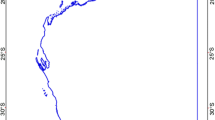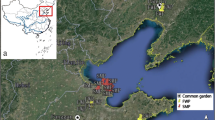Abstract
Aims
Responses to salt stress of two Gypsophila species that share territory, but with different ecological optima and distribution ranges, were analysed. G. struthium is a regionally dominant Iberian endemic gypsophyte, whereas G. tomentosa is a narrow endemic reported as halophyte. The working hypothesis is that salt tolerance shapes the presence of these species in their specific habitats.
Methods
Taking a multidisciplinary approach, we assessed the soil characteristics and vegetation structure at the sampling site, seed germination and seedling development, growth and flowering, synthesis of proline and cation accumulation under artificial conditions of increasing salt stress and effect of PEG on germination and seedling development.
Results
Soil salinity was low at the all sampling points where the two species grow, but moisture was higher in the area of G. tomentosa. Differences were found in the species’ salt and drought tolerance. The different parameters tested did not show a clear pattern indicating the main role of salt tolerance in plant distribution.
Conclusions
G. tomentosa cannot be considered a true halophyte as previously reported because it is unable to complete its life cycle under salinity. The presence of G. tomentosa in habitats bordering salt marshes is a strategy to avoid plant competition and extreme water stress.










Similar content being viewed by others
References
Alonso MA (1996) Flora y vegetación del Valle de Villena (Alicante). Instituto de Cultura Juan Gil-Albert, Alicante
Alvarado JJ, Ruiz JM, López-Cantarero I, Molero J, Romero L (2000) Nitrogen metabolism in five plant species characteristic of gypsiferous soils. Plant Physiol 156:612–616
Ashraf M, Foolad MR (2007) Roles of glycine betaine and proline in improving plant abiotic stress resistance. Environ Exp Bot 59:206–216
Ashraf MY (2009) Salt tolerance mechanisms in some halophytes from Saudi Arabia and Egypt. Res J Agric Biol Sci 5:191–206
Bates LS, Waldren RP, Tear LD (1973) Rapid determination of free proline for water-stress studies. Plant Soil 39:205–207
Ben-Gal A, Neori-Borochov H, Yermiyahu U, Shani U (2009) Is osmotic potential a more appropriate property than electrical conductivity for evaluating whole plant response to salinity? Environ Exp Bot 65:232–237
Biondi E (2011) Phytosociology today: Methodological and conceptual evolution. Plant Biosyst 145:19–29
Boscaiu M, Bautista I, Lidón A, Llinares J, Lull C, Donat P, Mayoral O, Vicente O (2013a) Environmental-dependent proline accumulation in plants living on gypsum soils. Acta Physiol Plant 35:2193–2204
Boscaiu M, Llul C, Llinares J, Vicente O, Boira H (2013b) Proline as a biochemical marker in relation to the ecology of two halophytic Juncus species. J Plant Ecol 6:177–186
Bradford KJ (1990) A water relations analysis of seed germination rates. Plant Physiol 94:840–849
Breckle SW (1999) Halophytic and gypsophytic vegetation of the Ebro-Basin at Los Monegros. In: Melic A, Blasco-Zumeta J (eds) Manifiesto científico por Los Monegros, vol 24, Bol. SEA., pp 101–104
Brenchley JL, Probert RJ (1998) Seed germination responses to some environmental factors in the sea grass Zoostera capricorni from eastern Australia. Aquat Bot 62:177–188
Cañadas EM, Ballesteros M, Valle F, Lorite J (2013) Does gypsum influence seed germination? Turk J Bot 38:141–147
Chen Z, Cuin TA, Zhou M et al (2007) Compatible solute accumulation and stress-mitigating effects in barley genotypes contrasting in their salt tolerance. J Exp Bot 58:4245–4255
Chutipaijit S, Cha-Um S, Sompornailin K (2009) Differential accumulation of proline and flavonoids in Indica rice varieties against salinity. Pak J Bot 41:2497–2506
Cushman JC (2001) Osmoregulation in plants: implications for agriculture. Am Zool 41:758–769
Debussche M, Thompson JD (2003) Habitat differentiation between two closely related Mediterranean plant species, the endemic Cyclamen balearicum and the widespread C. repandum. Acta Oecol 24:35–45
Eskandari H, Kazemi K (2011) Germination and seedling properties of different wheat cultivars under salinity conditions. Not Sci Biol 3:130–134
FAO (2006) Guidelines for soil descriptions, 5th edn. Food and Agricultural Organization of United Nation, Rome
Ferrandis P, Herranz JM, Copete MA (2005) Caracterización florística y edáfica de las estepas yesosas de Castilla-La Mancha. Invest Agrar Sist Recur For 14:195–216
Flowers TJ, Hall JL (1978) Salt tolerance in Suaeda maritima (L.) Dum. The effect of sodium chloride on growth and soluble enzymes in a comparative study with Pisum sativum L. J Exp Bot 23:310–321
Flowers TJ, Colmer TD (2008) Salinity tolerance in halophytes. New Phytol 179:945–963
Flowers TJ, Hajibagheri MA, Clipson NJW (1986) Halophytes. Q Rev Biol 61:313–335
García-Fuentes A, Salazar C, Torres JA, Cano E, Valle F (2001) Review of communities of Lygeum spartum L. in the south-eastern Iberian Peninsula (western Mediterranean). J Arid Environ 48:323–339
Géhu JM (2006) Dictionnaire de Sociologie et Synécologie Végétales. J. Cramer, Berlin-Stuttgart, p 899
Géhu JM (2011) On the opportunity to celebrate the centenary of modern phytosociology in 2010. Plant Biosyst 145(suppl):4–8
Ghassemi F, Jakeman AJ, Nix HA (1995) Salinisation of land and water resources: human causes, extent, management and case studies. Canberra, Australia. CAB International, The Australian National University, Wallingford
Grigore MN, Boscaiu M, Vicente O (2011) Assessment of the relevance of osmolyte biosynthesis for salt tolerance of halophytes under natural conditions. Eur J Plant Sci Biotech 5:12–19
Grigore MN, Villanueva M, Boscaiu M, Vicente O (2012a) Do halophytes really require salts for their growth and development? An experimental approach mitigation of salt stress-induced inhibition of Plantago crassifolia reproductive development by supplemental calcium or magnesium. Not Sci Biol 4:23–29
Grigore MN, Boscaiu M, Llinares J, Vicente O (2012b) Mitigation of salt stressed-induced Inhibition of Plantago crassifolia reproductive development by supplemental calcium or magnesium. Not Bot Horti Agrobo 40:58–66
Hare PD, Cress WA (1997) Metabolic implications of stress-induced proline accumulation in plants. Plant Growth Regul 21:79–102
Ishikawa SI, Kachi N (2000) Differential salt tolerance of two Artemisia species growing in contrasting coastal habitats. Ecol Res 15:241–247
Kebreab E, Murdoch AJ (1999) Modelling the effects of water stress and temperature on germination rate of Orobanche aegyptiaca seeds. J Exp Bot 50:655–664
Khan MA (2002) Halophyte seed germination: Success and Pitfalls. In: Hegazi AM, El-Shaer HM, El-Demerdashe S et al (eds) International symposium on optimum resource utilization in salt affected ecosystems in arid and semi arid regions. Desert Research Centre, Cairo, pp 346–358
Khan MA, Gul B, Weber DJ (2000) Germination responses of Salicornia rubra to temperature and salinity. J Arid Environ 45:207–214
Khan A, Rayner GD (2003) Robustness to non-normality of common tests for the many-sample location problem. J Appl Math Decis Sci 7:187–206
Lidón A, Boscaiu M, Collado F, Vicente O (2009) Soil requirements of three salt tolerant, endemic species from south-east Spain. Not Bot Horti Agrobo 37:64–70
López González G (1990) Gypsohila L. In: Castroviejo S, Laínz M, López G et al (eds) Flora Ibérica 2. Real Jardín Botánico, Madrid, pp 408–415
Lutts S, Kinet JM, Bouharmont J (1996) Effects of salt stress on growth, mineral nutrition and proline accumulation in relation to osmotic adjustment in rice (Oryza sativa L.) cultivars differing in salinity resistance. Plant Growth Regul 19:207–218
Madidi S, Baroudi B, Ameur FB (2004) Effects of salinity on germination and early growth of barley (Hordeum vulgare L.) cultivars. Int J Agric Biol 6:767–770
Marchal FM, Lendínez ML, Salazar C, Torres JA (2008) Aportaciones al conocimiento de la vegetación gispsícola en el occidente de la provincia de Granada (sur de España). Lazaroa 29:95–100
Médail F, Verlaque R (1997) Ecological characteristics and rarity of endemic plants from southern France and Corsica: implications for biodiversity conservation. Biol Conserv 80:269–281
Meyer SE (1986) The ecology of gypsophile endemism in the Eastern Mojave desert. Ecology 67:1303–1313
Moruno F, Soriano P, Oscar V, Boscaiu M, Estrelles E (2011) Opportunistic germination behaviour of Gypsophila (Caryophyllaceae) in two priority habitats from semi-arid Mediterranean steppes. Not Bot Horti Agrobo 9:18–23
Mota JF, Sánchez Gómez P, Merlo Calvente ME, Catalán Rodríguez P, Laguna Lumbreras E, de la Cruz RM, Navarro Reyes FB, Marchal Gallardo F, Bartolomé Esteban C, Martínez Labarga JM, Sainz Ollero H, Valle Tendero F, Serra Laliga L, Martínez Hernández F, Garrido Becerra JA, Pérez García FJ (2009) Aproximación a la checklist de los gipsófitos ibéricos. An Biol 31:71–80
Mota JF, Sola AJ, Jiménez-Sánchez ML, Pérez-García F, Merlo ME (2004) Gypsicolous flora, conservation and restoration of quarries in the southeast of the Iberian Peninsula. Biodivers Conserv 13:1797–1808
Munns R (2002) Comparative physiology of salt and water stress. Plant Cell Environ 25:239–250
Palacio S, Escudero A, Montserrat-Martí G, Maestro M, Milla R, Albert M (2007) Plants living on gypsum: beyond the specialist model. Ann Bot 99:333–343
Peinado M, Martínez-Parras JM (1982) Sobre la posición fitosociológica de Gypsophila tomentosa L. Lazaroa 4:129–140
Pueyo Y, Alados CL, Maestro M, Komac B (2007) Gypsophile vegetation patterns under a range of soil properties induced by topographical position. Plant Ecol 189:301–311
Rasband WS (1997–2012) ImageJ. U S National Institutes of Health. http://rsb.info.nih.gov/ij/, Bethesda, Maryland
Rivas-Martínez S (2005) Notions on dynamic-catenal phytosociology as a basis of landscape science. Plant Biosyst 139:135–144
Rivas-Martínez S, Rivas-Saenz S (1996–2009) Worldwide bioclimatic classification system, Phytosociological Research Center, Spain. http://www.globalbioclimatics.org. Accessed 1 July 2013
Rivas-Martínez S, Fernández-González F, Loidi J, Lousã M, Penas A (2001) Syntaxonomical checklist of vascular plant communities of Spain and Portugal to association level. Itinera Geobot 14:5–341
Salmerón-Sánchez E, Martínez-Nieto MI, Martínez-Hernández F, Garrido-Becerra JA, Mendoza-Fernández AJ, Gil de Carrasco C, Ramos-Miras JJ, Lozano R, Merlo ME, Mota JF (2014) Ecology, genetic diversity and phylogeography of the Iberian endemic plant Jurinea pinnata (Lag.) DC. (Compositae) on two special edaphic substrates: dolomite and gypsum. Plant Soil 374:233–250
Saradhi P, Alia P, Arora S, Prasad KV (1995) Proline accumulates in plants exposed to UV radiation and protects them against UV induced peroxidation. Biochem Biophys Res Commun 209:1–5
Sekmen AH, Turkan I, Tanyolac ZO, Ozfidan C, Dinc A (2012) Different antioxidant defense responses to salt stress during germination and vegetative stages of endemic halophyte Gypsophila oblanceolata Bark. Environ Exp Bot 77:63–76
Tipirdamaz R, Gagneul D, Duhaze C, Ainouche A, Monnier C, Ozkum D, Larher F (2006) Clustering of halophytes from an inland salt marsh in Turkey according to their ability to accumulate sodium and nitrogenous osmolytes. Environ Exp Bot 57:139–153
Ungar IA (1996) Effect of salinity on seed germination, growth, and ion accumulation of Atriplex patula (Chenopodiaceae). Am J Bot 83:604–607
USDA-ARS (2008) Research databases. Bibliography on salt tolerance. George E. Brown, Jr. Salinity Lab. US Dep. Agric., Agric. Res. Serv. Riverside, CA. http://www.ars.usda.gov/Services/docs.htm?docid=8908
USSL Staff (1954) Diagnosis and improvement of saline and alkali soils. US Department of Agriculture Handbook no. 60, 160 pp
Vicente O, Boscaiu M, Naranjo M, Estrelles E, Bellés JM, Soriano P (2004) Responses to salt stress in the halophyte Plantago crassifolia (Plantaginaceae). J Arid Environ 58:463–481
Author information
Authors and Affiliations
Corresponding author
Additional information
Responsible Editor: Jeffrey Walck.
Rights and permissions
About this article
Cite this article
Soriano, P., Moruno, F., Boscaiu, M. et al. Is salinity the main ecologic factor that shapes the distribution of two endemic Mediterranean plant species of the genus Gypsophila?. Plant Soil 384, 363–379 (2014). https://doi.org/10.1007/s11104-014-2218-2
Received:
Accepted:
Published:
Issue Date:
DOI: https://doi.org/10.1007/s11104-014-2218-2




